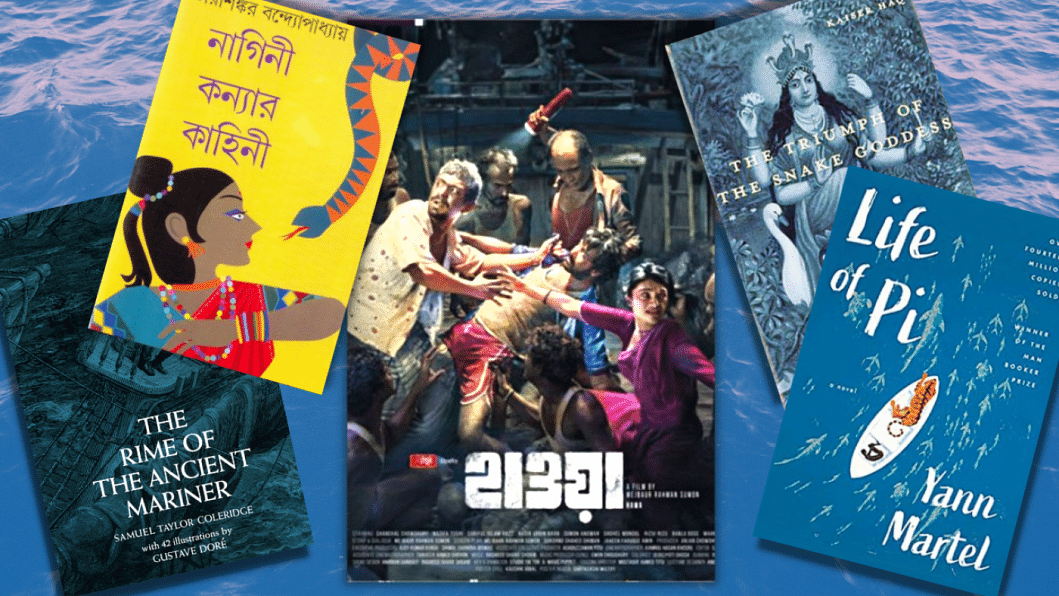What to read if you liked watching ‘Hawa’

Contemporary scandals, biopics of national heroes, a return to folk mythology—these are exciting times for moviegoers in Bangladesh, with storylines of the films developing on par with stunning cinematography and tasteful promotions.
Among these recent successes, Mejbaur Rahman Sumon's Hawa has been running successfully in 56 halls across the country as of this week, since releasing on July 29. The film is a deep dive into Bangladesh's rivers and the fishermen who hold up the country's underbelly, along with the revelry, the mythologies that run across the folk culture of majhis and Bede communities.
For book-lovers, the magic of Hawa can be found in the following books and stories.
NAGINI KANYAR KAHINI
Tarashankar Bandopadhyay, 1952
Much like Gulti, the woman who washes up on Chaan Majhi's boat in Hawa, Tarashankar's novel takes place amidst the religious customs and beliefs of the Bede people. A young Nagini becomes embroiled in a power struggle against the Shir Bede (head of Bede community); the plot shines light on the history and trajectory of the Bede people in Bengal, particularly on the rituals through which a young woman transforms into a Nagini.
THE RIME OF THE ANCIENT MARINER
Samuel Taylor Coleridge, 1798
Towards the end of Hawa, Chaan Majhi's interaction with a captivated Shalik bird has drawn media attention after representatives from the Wildlife Crime Control Unit decided to sue the director for how the antagonist treats the bird in the scene. Chaan Majhi's treatment of the bird is symbolic of the way he treats Gulti and all the other fishermen on his ship. The film, therefore, becomes a story of accountability and repentance.
Coleridge's iconic poem focuses entirely on this same encounter—how a Mariner, a man on a ship, learns to reckon with his actions after killing an albatross. It is a crime that comes to haunt all the remaining on the ship, seeking and demanding divine retribution.
THE TRIUMPH OF THE SNAKE GODDESS
Kaiser Haq, 2015
Snakes and snake goddesses have long held a place in other parts of South Asian culture. Scholar and poet Kaiser Haq's translation is the "first comprehensive retelling" of the myth of the goddess Manasa in English.
Haq retells the myth in prose from five surviving verse narratives of the story of Manasa, the snake goddess and miraculous child of God Shiva. Haq's prologue to the edition is a vital and useful survey of the Bengali oral, poetic, and manuscript traditions surrounding this folk epic. This is accompanied by an Introduction by Wendy Doniger, in which the scholar explores the history and importance of snake worship in classical Sanskrit texts.
LIFE OF PI
Yann Martel, 2001
The story of shipwreck and adventure is long familiar to us since the rousing success of Ang Lee's 2012 film adaptation starring Irrfan Khan, Suraj Sharma and Tabu. There are differences here—Martel's shipwrecked characters are novices in the ways of the water unlike Chaan Majhi and his fellow fishermen; his protagonist, Pi Patel, is the voice of human compassion and resilience after he loses his family at sea, stranded for 227 days on a boat with a Royal Bengal tiger.
It is the moral and philosophical undertones to both stories that align. In both Hawa and Life of Pi, the audience can "choose" a certain version of the story. They can choose to believe either in fantastical events that transcend the human capacity for imagination—that a young boy can outlive a wild orangutan, hyena, zebra, and seasick tiger—or they can lean towards a tale of natural human selfishness, which evolves from fear to murderous violence when survival is at stake.

 For all latest news, follow The Daily Star's Google News channel.
For all latest news, follow The Daily Star's Google News channel. 










Comments